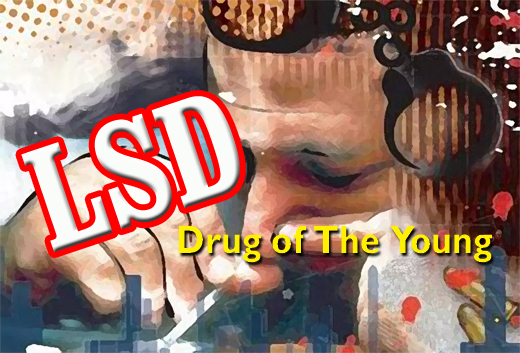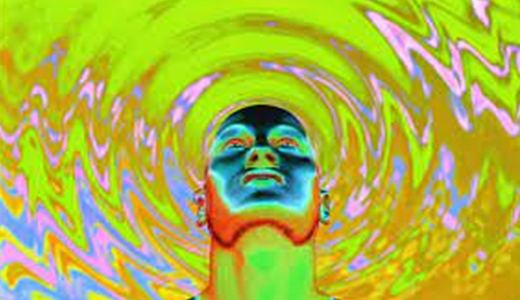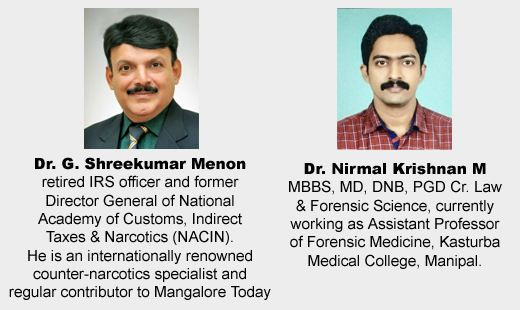Forensic Detection of Narcotic Drugs -II: LSD-Drug of The Young
Forensic Detection of Narcotic Drugs -II: LSD-Drug of The Young
Mangalore Today News Network
By Dr. G. Shreekumar Menon and Dr. Nirmal Krishnan
Mangaluru, January 3, 2022: Chemical escapism using Narcotics and Psychotropic Substances to find relief from depression, anxiety and general stress, has become very routine across the world. Late Harvard Psychologist Timothy Leary died almost 25 years ago, after which some of his ashes were launched into space, had used the expression “turning on and tuningin” to describe addiction to LSD, which is the most popular psychedelic of all times. Lysergic acid diethylamide (LSD), a hallucinogen is also known as an entactogen- “to touch within”. It is one of the most potent psychoactive compounds known to mankind. The drug is odourless, colourless, and slightly bitter tasting. It is usually taken by mouth and is rapidly absorbed by the gastrointestinal (GI) tract. It is a synthetic chemical, made from a substance found in ergot, which is a fungus that infects rye (grain). It belongs to a group of drugs known as Psychedelics. When small doses are taken, it can produce mild changes in perception, mood and thought. Larger doses produce visual hallucinations and distortions of space and time. It is usually sold in tiny amounts on blotter paper, as a liquid, or a pellet/micro-dot.

As a synthetic drug, LSD is created in a laboratory. Since there are no approved uses for LSD in this country, the laboratories in which the drug is made are not regulated. They may not even be real laboratories at all. They could be simple bathrooms or kitchens manned by unqualified people. The drugs these labs produce could be incredibly powerful, very weak, or somewhere in between. It’s impossible for the average buyer to determine the strength of the drug, without running lab tests. Also, without conducting lab tests, it’s difficult for users to know if the drugs they’re buying really contain LSD or are adulterated with unknown chemicals altogether. Each dose a teenager takes comes with these contamination and substitution risks.
As a hallucinogenic drug, LSD dampens or augments sensory signals in the brain. That means people under the influence of LSD often see things or feel things that they might not experience otherwise. People might feel as though they’re able to see sounds or hear colours. They might feel as though they can hear the thoughts of others. They might feel a benign sense of love for the world around them. LSD can also cause a “bad trip,” in which users experience terrifying visions, hallucinations or frightening emotions.
In its pure state, LSD is a white odourless crystalline substance. However, LSD is so potent that an effective dose of the pure drug is very minute that it’s virtually invisible. As a result, it is usually mixed and diluted with other chemicals. The most common form of sale is in the form of drops of LSD solution dried on to Gelatine sheets, pieces of blotting paper or sugar cubes, which release the drug when swallowed. LSD is also sometimes sold as a liquid, in a tablet or as capsules. LSD is usually swallowed or dissolved under the tongue, but it can also be sniffed, injected or smoked.
The effects of LSD usually begin in approximately 30 minutes and will last around 8-12 hours. The following may be experienced:
•euphoria and wellbeing
•dilation of pupils
•visual and auditory hallucinations.
•confusion and trouble concentrating
•headaches
•nausea
•fast or irregular heart beat
•increased body temperature
•breathing quickly
•vomiting
•facial flushes, sweating and chills.
A unique feature of LSD use is the occurrence of Flashbacks, meaning, recalling a frightening hallucination or terrifying vision. This can happen weeks, months or even years after the drug was last taken.

LSD has a fairly short half-life of three to four hours. That means that it only takes three to four hours for the body’s concentration of LSD to decrease by 50% (or one-half). Furthermore, 100% of the LSD ingested can take anywhere from 15to 28 hours to completely leave the body. Detection of LSD consumption in a laboratory is by analysing urine, blood, hair and saliva.
Drug testing is a cornerstone of drug court verdicts. The functioning of all NDPS Courts relies on the integrity and accuracy of the drug testing process as well as the immediacy with which drug testing services are accessed and the reliability of results obtained.Drug testing is a key component of drug prosecution cases, as, it provides readily available and objective information to the judge. Forensic drug testing is a complex science and requires the support of a forensic expert regardless of the testing method that is used. As with any scientific test, the interpretation of a drug test result requires balancing a number of factors, including elements directly related to the test, the physical characteristics of the individual being tested, and the nature and length of the individual’s drug usage. The value and usefulness of a drug testing regime are dependent on the scientific integrity of the drug testing process and the accurate interpretation and assessment of the raw data.
LSD, being consumed in a very small quantity, the detection of it also becomes very difficult by regular laboratory methods. Adding to the difficulty is the faster metabolism of the drug by the liver. As a person consumes LSD, it will be absorbed into the system through stomach and will reach the blood stream. It then starts producing hallucinogenic symptoms in the brain, but at the same time, the liver will start breaking it down into compounds like 2-oxo-3 hydroxyl LSDwhich can be detected over an extended period of time.
Urine is one of the samples where the LSD as a pure compound, or the metabolites can be detected. LSD will be excreted in urine unchanged up to 24 hours. The amount even though will be very less (up to 1% by 24 hours) can be still detected. The methods used are Ultra high-performance liquid chromatography and mass spectroscopy. The bye products are more easily detected because its concentration will be much higher than the actual compound. Immuno-affinity extraction units specifically designed for LSD can be used to detect the antibodies produced by the body against LSD in urine. Currently available tests cannot detect the presence of LSD after 72 hours of use. The testing done with urine sample always has a possibility of having false positive tests with medications like Ambroxol and Amitryptyline.
From blood, the detection is possible using similar methods, like that used for urine analysis. The detection of the LSD sample decreases as the time passes by.Ultra-high-performance liquid chromatography and tandem mass spectrometry can be used to detect the presence of the chemical in blood samples. The problem with the technique is that it cannot be used for detection of day-to-day drug abuse specimens because of the sophisticated instruments involved and the cost.
Hair is another sample which can give a clue about LSD usage. The scalp hair shows the presence of the drug even at pico gram levels per milligram of shaft. It is also helpful in determining the approximate time lapse since the last usage of the drug based on the location of the sample on the shaft of the hair. The pubic hair samples may give a better clue as they may be contaminated by urine containing LSD. Studies have shown that hair samples have tested positive even after 90 days of exposure to LSD. However, since the required drug dosage for the hallucinating effects is very low, a negative test on the hair sample, doesn’t mean that the person has not abused the drug.
The post-mortem samples like brain, lung, kidneys can give a better sample for the detection of the chemical.Thus, the main factor affecting the detection of the drug is the time lapse from the moment of use to the collection of the sample.
Although drug test results are frequently reported in terms of “positive” or “negative,” in reality, the determination of the presence or absence of a particular drug in the system is not always a black-and-white determination. Ultimately, for a drug related prosecution, a positive or negative result reflects the presence or absence of certain drug metabolites in the sample at a concentration above or below the established cut-off concentration. How the laboratory interprets such results and the court responds to them depends upon a complex set of factors requiring an understanding of:
• the biological process that affects the length of time different drugs stay in the human body
• interactions of one drug with another
• distribution and elimination rates of the drugs in question
• the accused person’s drug history and other physical characteristics
• the capacity of the testing procedures to identify potential adulteration (e.g., flushing or water loading) that may affect the test results
• the effect of other variables, such as the individual’s health, physical condition, and duration of drug use, on the test analysis.
The detection of LSD still remains as a challenge for the scientific world and the law enforcement agencies.The criminal justice system has historically accepted forensic science testimony with great trust. However, over the past 25 years, Deoxyribonucleic acid ("DNA") testing has revealed the limitations of scientific evidence by conclusively proving innocence in cases in which forensic analysts had previously presented evidence of guilt. DNA exoneration cases have prompted a more critical evaluation of forensic science in general. This evaluation has revealed a range of problems including the misapplication of otherwise solid science, overstated conclusions, and some disciplines that lack fundamental scientific foundations. DNA exoneration cases provides a glimpse of the limitations of forensic science.
Writers can be contacted at: shreemenon48@gmail.com and drnirmalknambiar@gmail.com

- Need For ‘Students, Alcohol and Drugs’ survey
- New Synthetic Drugs Trapping Youth
- Mood Modifying Chips - Future of Drug Use
- Ramping up Indo-Bangla border security
- IITM- A premier educational Institution in a forest. What can we learn?
- Former PM, Manmohan Singh: Notable laws passed under his tenure
- Hashish on Ratnagiri Seashore
- The Poor cry out to Us: Do we respond?
- Clandestine Meth Labs Sprouting Across India
- Hydro ganja from Bangkok latest craze among youth in India
- "Memories to Treasure" Dr.Michael Lobo’s new book
- Dominance of Private Universities: Will it make education inaccessible to underprivileged students?
- Monti Phest: A rich heritage of South Canara
- Kashmir Bhavan in Bengaluru: A must visit place
- "MAI and I" Book of Angelic Emotions
- Draupadi Murmu - The New ’President of India’
- Anthony Ashram in the city grows a classic museum
- First College of Fisheries in India - A Golden Jubilarian
- Flushing Meadows - A Vintage Mansion
- The Colonel�s Bequest
- A Mangalorean PM and his RBI Governor Brother: The Extraordinary story of the Benegal Brothers
- There is no higher religion than Truth: Theosophical Society
- L�affaire - Ashu & Yiju of Mangalore
- Mangalore in Kowloon
- 1568 to 2018 AD: 450 years of Christianity in Mangaluru
- Vice President elect Naidu moves on from nadir to zenith, the phenomenal journey
- Embracing the Outdoors: How Heated Jackets Are Revolutionizing Cold Weather Activities
- Efficient and Sustainable Packaging Solutions with FIBCs
- The Hybrid Kilt Revolution | Where Tradition Gets Trendy
- Affordable Elegance | Embrace Style on a Budget with Cheap Kilts
- Unleashing Style and Functionality | Exploring Tactical Kilts
- Mangalore’s Heroic Lady marks 105th Birthday
- Santa the Christmas spirit
- Geriatric care: Mangalore strikes a fine balance
- The Don Who Made Two Empires to Clash
- CHITRAPUR SARASWATS - A Great Kanara Community
- Our new President Ram Nath Kovind’s significant journey to Rashtrapathi Bhavan
- Marriages made in heaven, big fat weddings made in India
- Eid insight - The giver of glad tidings
- CITY INFORMATION
- TRAVEL
- TOURIST INFORMATION
- HEALTH CARE
- MISCELLANEOUS




 Write Comment
Write Comment E-Mail To a Friend
E-Mail To a Friend Facebook
Facebook Twitter
Twitter  Print
Print 


